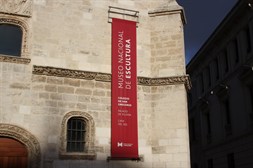A museum which is over a hundred years old
 The Museo Nacional de Escultura, National Sculpture Museum of Valladolid, is one of the oldest museums in Spain. Founded in 1842 as the Museo Provincial de Bellas Artes and installed in the Colegio de Santa Cruz, it was formed with the art treasures from the convents were suppressed in 1836 after the Desamortización. In 1933, in order to celebrate the rich heritage of the nation and to encourage the scientific study of major works of art, the Second Republic elevated the institution to the category of the Museo Nacional de Escultura, transferring it to the Colegio de San Gregorio. Since then, the collection stored therein has been steadily growing thanks to bequests of private donor, deposits and purchases by the Spanish state. After the renovation of the headquarters and the modernization of the entire structure, the Museum reopened its doors to the public in 2009.
The Museo Nacional de Escultura, National Sculpture Museum of Valladolid, is one of the oldest museums in Spain. Founded in 1842 as the Museo Provincial de Bellas Artes and installed in the Colegio de Santa Cruz, it was formed with the art treasures from the convents were suppressed in 1836 after the Desamortización. In 1933, in order to celebrate the rich heritage of the nation and to encourage the scientific study of major works of art, the Second Republic elevated the institution to the category of the Museo Nacional de Escultura, transferring it to the Colegio de San Gregorio. Since then, the collection stored therein has been steadily growing thanks to bequests of private donor, deposits and purchases by the Spanish state. After the renovation of the headquarters and the modernization of the entire structure, the Museum reopened its doors to the public in 2009.
The Museum extends along a pedestrian street, Calle de Cadenas de San Gregorio in Valladolid’s old town and occupies three buildings of great artistic value.
The first of them, the Colegio de San Gregorio, is a jewel of Iberian architecture of the end of the fifteenth century. The chapel, the patio and the façade (see the photo on the next page) are noted for the elegance of their ornaments, elegant proportions and curious iconography which combines wild men and emblems of power to symbolize the new monarchy of the Catholic Kings. The artistic value of the building, the first real work of art in the collection, is confirmed by the use of the original structure, as a place for teaching theology by the Dominicans, able to exert considerable political and religious influence on Habsburg Spain. In this sense, there is a clear affinity with the core theme of the sculpture collections which are exposed in it, thus offering a valuable record of the Spanish past.
The College is located in front of the palacio de Villena, a noble’s residence dating back to the sixteenth century. It is a multi-purpose building intended for temporary exhibitions, educational activities and programs of public interest. The palace also houses a library specializing in sculpture which consists of over 30,000 volumes, the salón de actos and shops of restoration and photography. There is also a eighteenth century Neapolitan nativity scene, which includes more than 600 pieces.
The third location, the Casa del Sol, was the residence of the Count of GondomarDiego Sarmiento de Acuña (1567-1626) was a Spanish nobleman and diplomat. An ambassador in England between 1613 and 1622, he was one of the most prominent figures during the reign of Philip III. A scholar and bibliophile, he possessed one of the most important private libraries of the time. He was also a Knight of the Order of Calatrava and the Count of Gondomar., an influential diplomat and erudite bibliophile in the Spain of Philip III. The adjoining church (San Benito el Viejo), which was recently restored, houses the collection of the old Museo Nacional de Reproducciones Artísticas which has long since closed.
With the increase of the collections and the opening of new spaces in recent years, the National Sculpture Museum has established itself as a “museum complex”, composed of buildings of high architectural value that have qualified the entire area as one of the most attractive spaces in the city, and from a cultural point of view, in all of Spain.
